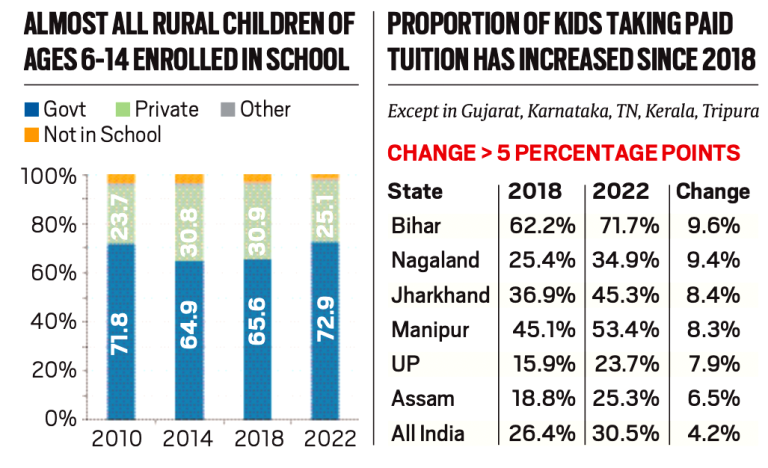Description

About:
- Annual Status of Education Reports (ASER) survey records trends in school enrollment, attendance, and reading and arithmetic abilities.
- This year, nearly 7 lakh children in the age group of 6 to 14 across 616 districts were surveyed.
Key Points of the Report:
- Despite school closures during the pandemic, the overall enrolment rate for the 6 to14 age group, increased from 97.2% in 2018 to 98.4% in 2022.
- Attendance patterns haven’t changed very much and there is a huge variation in attendance across the country.
- Government schools have seen a sharp increase in children enrolled from 65.6% in 2018 to 72.9% in 2022.
- During Covid, the rural private schools couldn’t do much because of their financial issues, but at the same time government schools distributed textbooks, and they often distributed midday meals, this worked as a pull factor in increasing enrolment in government schools.
- At the National level, the proportion of children in classes 1 to 8 taking paid private tuition classes increased from 26.4% in 2018 to 30.5% in 2022.
- Bihar and Jharkhand are high-tuition states; 70% of children in Bihar and 45% in Jharkhand are taking tuition in 2022 as compared to only 10% of children in Himachal Pradesh and 15% in Maharashtra.
- The percentage of children in Class 3 in government or private schools who were able to read at the level of Class 2 dropped from 27.3% in 2018 to 20.5% in 2022.
- This decline is visible in every State, and for children in both government and private schools.
- Almost 80% of the schools reported that they have received guidelines and teachers have been trained.
- There is a decline in learning levels since 2018, but again it varies across the country.
- Drop in reading is more than in math.
- The report suggested integration between the Anganwadi system and the school system is urgently needed to ensure overall learning development.
.jpeg)
Annual Status of Education Report (ASER):
- ASER is an annual survey that aims to provide district-level information on children’s enrolment and basic learning.
- The Survey has been conducted every year since 2005 in all rural districts of India.
- It is a household-based survey rather than a school-based survey.
- This enables all children to be included; those who have never been to school or have dropped out, as well as those who are in government schools, private schools, religious schools or anywhere else.
- Information on learning is collected from children in the age group 3-16.
- Basic household information is also collected.
- Recently, this has included household size, parental education, and some information on household assets.
- Children in the age group 5-16 are tested in basic reading and basic arithmetic.
- ASER standards have been adopted in several countries: Kenya, Uganda, Tanzania, Pakistan, Mali and Senegal.
Challenges in Indian Education System:
- India has achieved universal enrolment at the elementary level. This is a great achievement, but getting Students to School is only the beginning of human Capital formation.
- Poor quality of facilities, Shortage of qualified faculty.
- Outdated Curriculum, Limited university-industry Partnership.
- Indian origin Scientists have won the Nobel Prize, but post-independence work done in India has not led to a Science novel. If Indians Studying and working abroad can have a great impact, then obviously the problem has to do with our Systems of education and research.
- Broken Governance System. There are few rewards for being a good teacher and few Punishments for being a Careless one. Need more effective and accountable governance Systems.
- The greed of Private Colleges to earn the maximum from every Student puts traumatic Pressure on Students which results in mental breakdown.
- More girls than boys drop out of School. While boys drop out to work, girls usually Stay at home and help with domestic Work. Social Conception of gender roles is an important factor.
- Learning loss due to pandemics and the digital divide.

Steps taken by the Government to reform the Education sector:
- The 86th Constitution Amendment provides the Fundamental right to free and compulsory education under Article 21A includes a Common education System where the “rich and Poor are educated under one roof".
- Rashtriya Uchchatar Shiksha Abhiyan provides funding to eligible State higher educational institutions.
- Declaration of Educational Institutions as institutions of Eminence, to provide world-class education to Indian Students within the Country.
- Creation of Higher Education Financing Agency, for high-quality infrastructure in Premier educational institutions.
- National Institution Ranking Framework for ranking our higher education institutions.
- GIAN Initiative invites distinguished academicians, entrepreneurs, scientists, and experts from premier institutions across the world to teach in higher educational institutions in India.
- SWAYAM Portal for Online Courses.
- SWAYAM Prabha Provide HD educational Channels through DTH on a 24X7 basis.
- Sodhganga to develop a national repository of universities in India, digital Study material for higher education.
- Samagra Shiksha Scheme to ensure inclusive and equitable quality education at all levels of school education.
- The government is encouraging Open Online Courses via Swayam Platforms So that Students Can have access to quality lectures online.
- Artificial Intelligence (AI) can be used to Provide Personalized instructions based on Student needs.
- The government needs to work on improving digital infrastructure and ensure that students have access to mobile phones or laptops.

https://indianexpress.com/article/explained/expert-explains-bright-spots-areas-of-concern-in-aser-2022-8390503/














